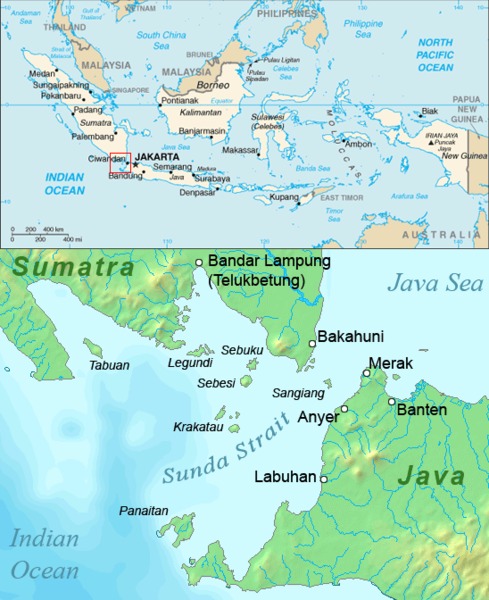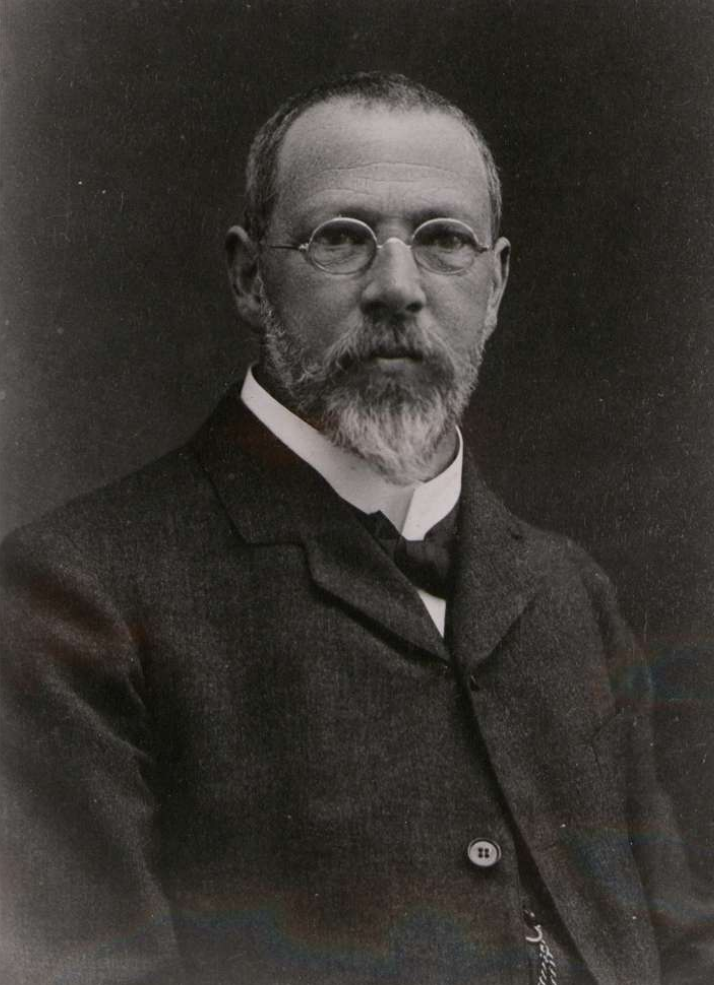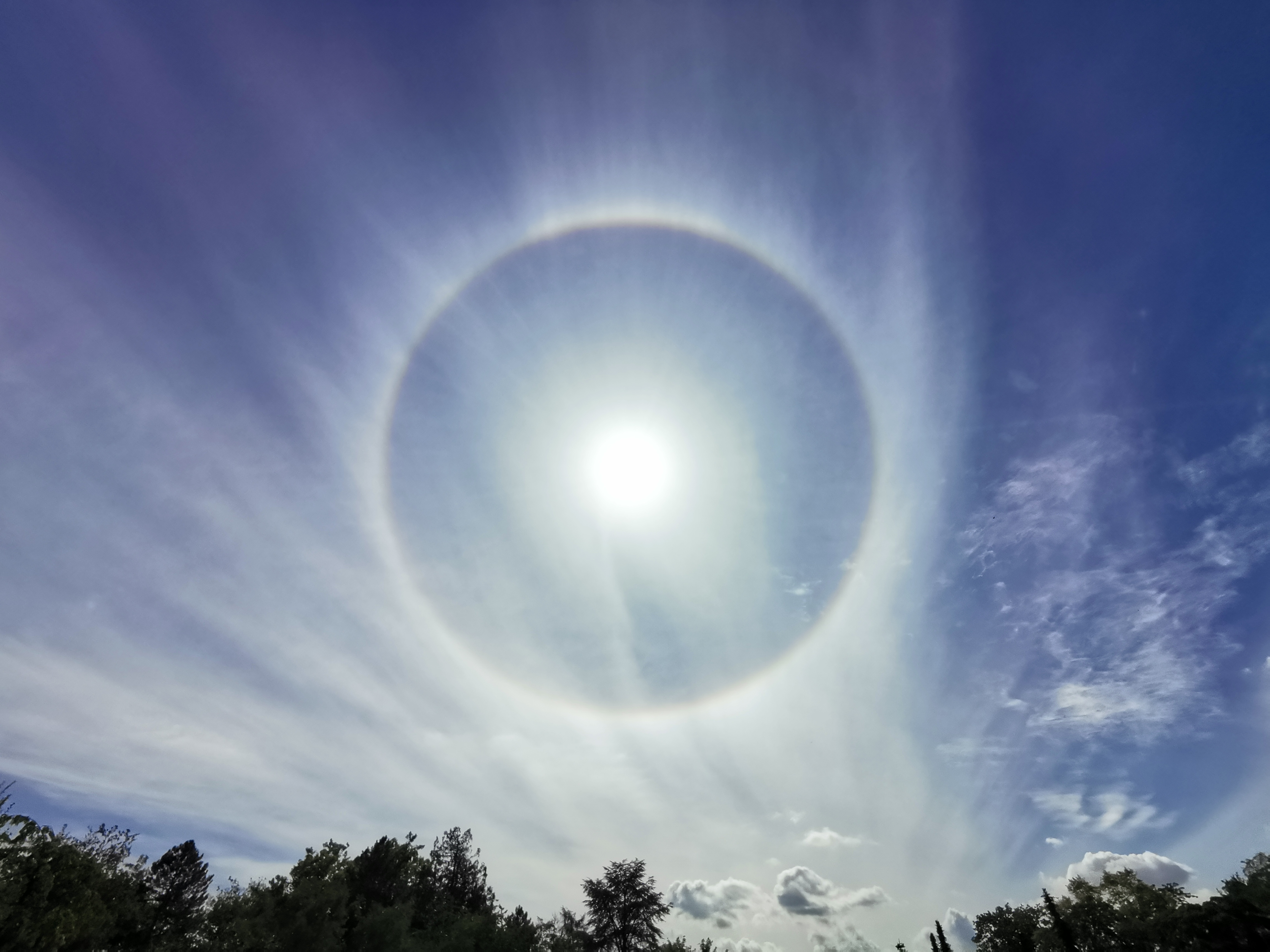|
Bishop's Ring
A Bishop's Ring is a diffuse brown or bluish halo observed around the sun. It is typically observed after large volcanic eruptions. The first recorded observation of a Bishop's Ring was by Rev. Sereno Edwards Bishop of Honolulu, after the Krakatoa eruption of August 27, 1883. This gigantic explosion threw a vast quantity of dust and volatile gases into the atmosphere. Sulfate aerosols remained in the stratosphere, causing colorful sunrises and sunsets for several years. The first observation of this ring was published in 1883, being described as a “faint halo” around the sun. Bishop observed the phenomenon on September 5, 1883; the phenomenon was subsequently named after him, and was the subject of an 1886 professorial dissertation (''Habilitationsschrift'') by Albert Riggenbach. Most observations agree that the inner rim of the ring is whitish or bluish white and that its outside is reddish, brownish or purple. The area enclosed by the ring is significantly brighter than i ... [...More Info...] [...Related Items...] OR: [Wikipedia] [Google] [Baidu] |
Halo (optical Phenomenon)
A halo is an optical phenomenon produced by light (typically from the Sun or Moon) interacting with ice crystals suspended in the atmosphere. Halos can have many forms, ranging from colored or white rings to arcs and spots in the sky. Many of these appear near the Sun or Moon, but others occur elsewhere or even in the opposite part of the sky. Among the best known halo types are the circular halo (properly called the 22° halo), light pillars, and sun dogs, but many others occur; some are fairly common while others are extremely rare. The ice crystals responsible for halos are typically suspended in cirrus or cirrostratus clouds in the upper troposphere (), but in cold weather they can also float near the ground, in which case they are referred to as diamond dust. The particular shape and orientation of the crystals are responsible for the type of halo observed. Light is reflected and refracted by the ice crystals and may split into colors because of dispersion. The ... [...More Info...] [...Related Items...] OR: [Wikipedia] [Google] [Baidu] |
Volcano
A volcano is a rupture in the crust of a planetary-mass object, such as Earth, that allows hot lava, volcanic ash, and gases to escape from a magma chamber below the surface. On Earth, volcanoes are most often found where tectonic plates are diverging or converging, and most are found underwater. For example, a mid-ocean ridge, such as the Mid-Atlantic Ridge, has volcanoes caused by divergent tectonic plates whereas the Pacific Ring of Fire has volcanoes caused by convergent tectonic plates. Volcanoes can also form where there is stretching and thinning of the crust's plates, such as in the East African Rift and the Wells Gray-Clearwater volcanic field and Rio Grande rift in North America. Volcanism away from plate boundaries has been postulated to arise from upwelling diapirs from the core–mantle boundary, deep in the Earth. This results in hotspot volcanism, of which the Hawaiian hotspot is an example. Volcanoes are usually not created where two tectonic ... [...More Info...] [...Related Items...] OR: [Wikipedia] [Google] [Baidu] |
Sereno Edwards Bishop
Sereno Edwards Bishop (February 7, 1827 – March 23, 1909) was a scientist, Presbyterian minister and publisher. He was an avid proponent of the United States annexation of the Hawaiian Islands, and aligned himself with the political faction who overthrew the monarchy under Liliuokalani. Early life He was born in the Kingdom of Hawaii during the reign of Kamehameha III, to missionaries Rev. Artemas Bishop and Elizabeth Edwards Bishop at Kaʻawaloa on the island of Hawaii. At the time of his birth, his father was in the process of translating the Bible into the Hawaiian language. His mother died three weeks after he was born, and his father remarried in December to Delia Stone Bishop. Ministry and teaching profession At the age of twelve, he was sent back to the mainland for his education, graduating from Amherst College and Auburn Theological Seminary. He married Cornelia Ann Session on May 31, 1852, and was ordained into the ministry in June at the Third Presbyterian Chu ... [...More Info...] [...Related Items...] OR: [Wikipedia] [Google] [Baidu] |
Honolulu
Honolulu (; ) is the capital and largest city of the U.S. state of Hawaii, which is in the Pacific Ocean. It is an unincorporated county seat of the consolidated City and County of Honolulu, situated along the southeast coast of the island of Oahu, and is the westernmost and southernmost major U.S. city. Honolulu is Hawaii's main gateway to the world. It is also a major hub for business, finance, hospitality, and military defense in both the state and Oceania. The city is characterized by a mix of various Asian, Western, and Pacific cultures, reflected in its diverse demography, cuisine, and traditions. ''Honolulu'' means "sheltered harbor" or "calm port" in Hawaiian; its old name, ''Kou'', roughly encompasses the area from Nuuanu Avenue to Alakea Street and from Hotel Street to Queen Street, which is the heart of the present downtown district. The city's desirability as a port accounts for its historical growth and importance in the Hawaiian archipelago and the broader ... [...More Info...] [...Related Items...] OR: [Wikipedia] [Google] [Baidu] |
Krakatoa
Krakatoa (), also transcribed (), is a caldera in the Sunda Strait between the islands of Java and Sumatra in the Indonesian province of Lampung. The caldera is part of a volcanic island group ( Krakatoa archipelago) comprising four islands. Two, Lang and Verlaten, are remnants of a previous volcanic edifice destroyed in eruptions long before the famous 1883 eruption; another, Rakata, is the remnant of a much larger island destroyed in the 1883 eruption. In 1927, a fourth island, Anak Krakatoa, or "Child of Krakatoa", emerged from the caldera formed in 1883. There has been new eruptive activity since the late 20th century, with a large collapse causing a deadly tsunami in December 2018. Historical significance The most notable eruptions of Krakatoa culminated in a series of massive explosions over 26–27 August 1883, which were among the most violent volcanic events in recorded history. With an estimated Volcanic Explosivity Index (VEI) of 6, the eruption was e ... [...More Info...] [...Related Items...] OR: [Wikipedia] [Google] [Baidu] |
Albert Riggenbach
Albert Riggenbach (22 August 1854 – 28 February 1921), also known as Albert Riggenbach-Burckhardt, was a Swiss meteorologist and co-author, with Hugo Hildebrandsson and Léon Teisserenc de Bort, of one of the first cloud atlases, the ''International Cloud Atlas'' in 1896. His doctoral dissertation (''Habilitationsschrift'') concerned observations of the first described Bishop's Ring. A great nephew of Swiss architect Achilles Huber, he married in 1883 Valerie Burckhardt, daughter of Daniel Burckhardt, descending from an influential family of Basel. In 1880, he became assistant for Astronomy and Meteorology at the Physics Institute in Basel and was professor at the University of Basel between 1899 and 1914. In the 1890s, Riggenbach also took the first successful pictures of cirrus clouds, some of which appeared in the 1896 cloud atlas he co-authored. Bibliography *1886 ''Beobachtungen über die Dämmerung, insbesondere über das Purpurlicht und seine Beziehungen zum Bishop'schen ... [...More Info...] [...Related Items...] OR: [Wikipedia] [Google] [Baidu] |
Diffraction
Diffraction is defined as the interference or bending of waves around the corners of an obstacle or through an aperture into the region of geometrical shadow of the obstacle/aperture. The diffracting object or aperture effectively becomes a secondary source of the propagating wave. Italian scientist Francesco Maria Grimaldi coined the word ''diffraction'' and was the first to record accurate observations of the phenomenon in 1660. In classical physics, the diffraction phenomenon is described by the Huygens–Fresnel principle that treats each point in a propagating wavefront as a collection of individual spherical wavelets. The characteristic bending pattern is most pronounced when a wave from a coherent source (such as a laser) encounters a slit/aperture that is comparable in size to its wavelength, as shown in the inserted image. This is due to the addition, or interference, of different points on the wavefront (or, equivalently, each wavelet) that travel by paths of ... [...More Info...] [...Related Items...] OR: [Wikipedia] [Google] [Baidu] |
Eduard Hagenbach-Bischoff
Eduard Hagenbach-Bischoff (20 February 1833, in Basel – 23 December 1910, in Basel) was a Swiss physicist. The Hagenbach-Bischoff quota (a voting system) is named after him. The son of the theologian Karl Rudolf Hagenbach, he studied physics and mathematics in Basel (with Rudolf Merian), Berlin (with Heinrich Wilhelm Dove and Heinrich Gustav Magnus), Geneva, Paris (with Jules Célestin Jamin) and obtained his Ph.D. in 1855 at Basel. He taught at the ''Gewerbeschule'' (vocational school) in Basel and was after his habilitation, a professor of mathematics at the University of Basel for one year. From 1863 to 1906 he was a full professor of physics at Basel (successor of Gustav Heinrich Wiedemann). In 1874 he became director of the institute of physics at the newly founded “Bernoullianum” in Basel, and from 1874 to 1879 he was president of the Swiss Academy of Sciences. Hagenbach-Bischoff was involved in the popularisation of science, and at the “Bernoullianum” he gave m ... [...More Info...] [...Related Items...] OR: [Wikipedia] [Google] [Baidu] |
22° Halo
A 22° halo is an atmospheric optical phenomenon that consists of a halo with an apparent radius of approximately 22° around the Sun or Moon. When visible around the Moon, it is also known as a moon ring or winter halo. It forms as sunlight or moonlight is refracted by millions of hexagonal ice crystals suspended in the atmosphere. Its radius is roughly the length of an outstretched hand at arm's length. Formation Even though it is one of the most common types of halo, the exact shape and orientation of the ice crystals responsible for the 22° halo are the topic of debate. Hexagonal, randomly oriented columns are usually put forward as the most likely candidate, but this explanation presents problems, such as the fact that the aerodynamic properties of such crystals leads them to be oriented horizontally rather than randomly. Alternative explanations include the involvement of clusters of bullet-shaped ice columns. As light passes through the 60° apex angle of th ... [...More Info...] [...Related Items...] OR: [Wikipedia] [Google] [Baidu] |
Japan
Japan ( ja, 日本, or , and formally , ''Nihonkoku'') is an island country in East Asia. It is situated in the northwest Pacific Ocean, and is bordered on the west by the Sea of Japan, while extending from the Sea of Okhotsk in the north toward the East China Sea, Philippine Sea, and Taiwan in the south. Japan is a part of the Ring of Fire, and spans an archipelago of 6852 islands covering ; the five main islands are Hokkaido, Honshu (the "mainland"), Shikoku, Kyushu, and Okinawa. Tokyo is the nation's capital and largest city, followed by Yokohama, Osaka, Nagoya, Sapporo, Fukuoka, Kobe, and Kyoto. Japan is the eleventh most populous country in the world, as well as one of the most densely populated and urbanized. About three-fourths of the country's terrain is mountainous, concentrating its population of 123.2 million on narrow coastal plains. Japan is divided into 47 administrative prefectures and eight traditional regions. The Greater Tokyo Ar ... [...More Info...] [...Related Items...] OR: [Wikipedia] [Google] [Baidu] |
Mount Pinatubo
Mount Pinatubo is an active stratovolcano in the Zambales Mountains, located on the tripoint boundary of the Philippine provinces of Zambales, Tarlac and Pampanga, all in Central Luzon on the northern island of Luzon. Its eruptive history was unknown to most before the pre-eruption volcanic activity of early 1991. Pinatubo was heavily eroded and obscured from view by dense forests which supported a population of several thousand indigenous Aetas. Pinatubo is most notorious for its VEI-6 eruption on June 15, 1991, the second-largest terrestrial eruption of the 20th century after the 1912 eruption of Novarupta in Alaska. Complicating the eruption was the arrival of Typhoon Yunya, bringing a lethal mix of ash and rain to towns and cities surrounding the volcano. Predictions at the onset of the climactic eruption led to the evacuation of tens of thousands of people from the surrounding areas, saving many lives. Surrounding areas were severely damaged by pyroclastic ... [...More Info...] [...Related Items...] OR: [Wikipedia] [Google] [Baidu] |








